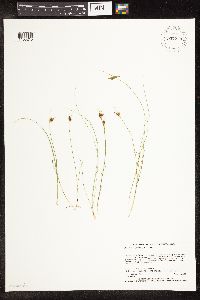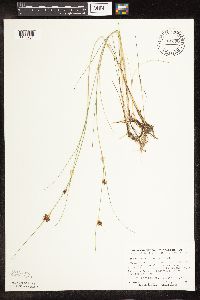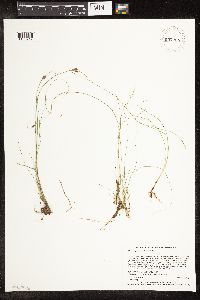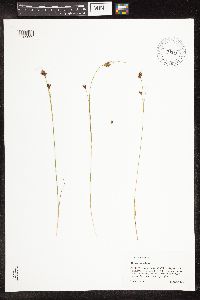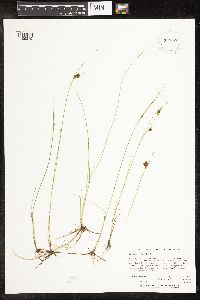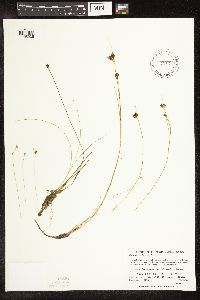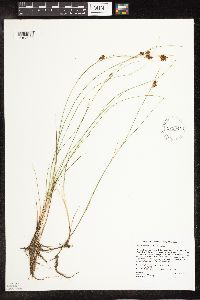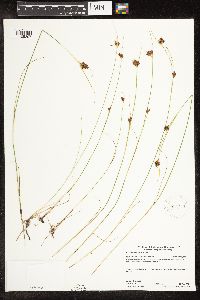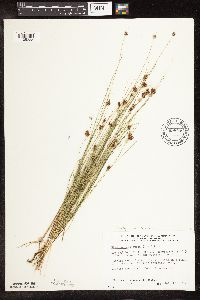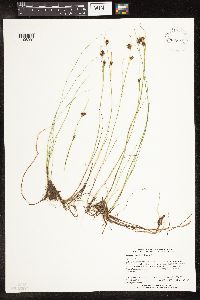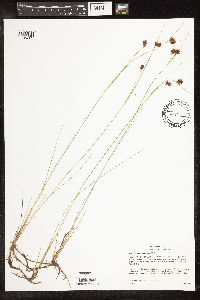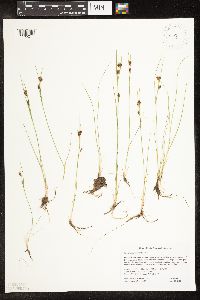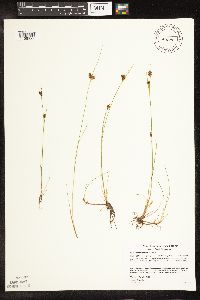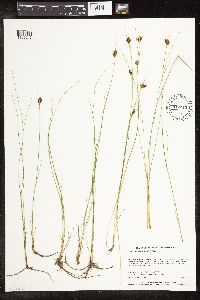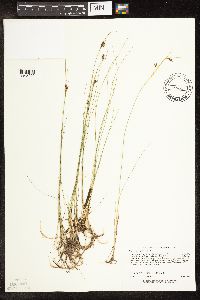Rhynchospora fusca
|
|
|
|
Family: Cyperaceae
Brown Beak Sedge
|
Plants perennial, cespitose, 10-50 cm; rhizomes stoloniferous, slender. Culms erect to excurved, filiform, leafy, ± terete. Leaves shorter than culm; blades ascending, filiform, proximally to 1.5(-2)mm wide, apex trigonous, tapering, setaceous. Inflorescences: lateral spikelet clusters (0-)1-2, distant, terminal cluster ellipsoid to broadly turbinate or hemispheric, branches ascending; leafy bracts setaceous, overtopping clusters. Spikelets red-brown to deep brown, lanceoloid, (4-)5-6(-7) mm, apex acute; fertile scales lanceolate, 4-5(-6) mm, apex acuminate, midrib often excurrent as awn. Flowers: bristles 5-6, longest reaching at least past tubercle base, mostly to tip or beyond, antrorsely barbellate. Fruits 2(-3) per spikelet, (2.3-)2.5-2.6(-3) mm with pedicellar joint, receptacle, and tubercle; body lustrous, pale brown to deep brown, obovoid to ellipsoid, lenticular, 1-1.5 × 1 mm, margins narrow, flowing to tubercle; surfaces longitudinally finely lined, transversely very finely ridged with wavy rows of very narrow, vertical lattices, sometimes also with lines of shallow pits; tubercle triangular subulate, (0.7-)1-1.3(-1.5) mm, base lunate, margins setulose proximally. Fruiting summer-fall. Sands and peats of pond shores, bogs, and seeps; 0-400 m; N.B., Nfld. and Labr., N.S., Ont., Que., Sask.; Conn., Del., Ill., Ind., Maine, Md., Mass., Mich., Minn., N.H., N.J., N.Y., Pa., R.I., Vt., Wis.; Europe. Perennial herb with slender rhizomes, tufted, colonial 10 cm - 0.5 m tall Leaves: alternate, ascending, mostly shorter than culms, to 1.5 mm wide, thread-like with a tapering and three-sided tip, parallel-veined, with a sheathing base that encloses the stem. Sheaths opening at the top. Inflorescence: consisting of one to three, lateral and terminal spikelet clusters, each subtended by a leaf-like bract. Bracts bristle-like, overtopping the spikelet clusters. Spikelet clusters 1 - 1.5 cm long, 0.5 - 1 cm wide, egg-shaped or hemispheric, the lower ones on an exserted stalk. Flowers: minute, subtended by a floral scale, lacking sepals and petals, bearing five to six bristles. Stamens exserted. Pistil one. Style two-cleft. Fruit: a one-seeded achene, two or three per spikelet, light brown, 1 - 1.5 mm long (not including tubercle), about 1 mm wide, reverse egg-shaped to ellipsoid, biconvex, margins narrow, smooth at 10x. Tubercle 1 - 1.5 mm long, triangular to awl-shaped with a crescent-shaped base, margins minutely bristly basally. Culm: curved to upright, 10 cm - 0.5 m long, overtopping leaves, very thin, more or less circular in cross-section, solid, leafy. Spikelets: reddish brown to dark brown, 4 - 6 mm long, lance-shaped with a pointed apex, with two or three flowers. Floral scales spirally arranged and overlapping, 4 - 5 mm long, lance-shaped with a pointed apex, midrib often extending beyond the tip as an awn. Similar species: No information at this time. Habitat and ecology: Rare in the Chicago Region and known only from Berrien County, Michigan. It grows in marshy areas and swales. Occurence in the Chicago region: native Etymology: Rhynchospora comes from the Greek words rhynchus, meaning beak, and spora, meaning seed, referring to the beaked achene. Fusca means dusky or brown. Author: The Morton Arboretum Colonial by slender rhizomes; stems 1.5-4 dm; lvs very slender, involute, mostly shorter than the stems; infl of 1-3 turbinate or ovoid glomerules 10-15 נ5-12 mm, the lower on exsert peduncles, each subtended and much surpassed by an erect foliaceous bract; spikelets 4-6 mm, dark brown, with 2-3 fls and frs; bristles antrorsely barbellate, 3 about equaling the tubercle, 2 or 3 about equaling the achene; achenes obovate or triangular-obovate to pyriform, 1.1-1.4 mm, three-fourths as wide, light brown, smooth at 10 tubercle flat-subulate, 0.7-1.5 mm; 2n=26, 32. Bogs and marshes; Nf. and Que. to Sask., s. to Del., Md., N.Y., Mich., and Minn.; also in Europe. Gleason, Henry A. & Cronquist, Arthur J. 1991. Manual of vascular plants of northeastern United States and adjacent Canada. lxxv + 910 pp. ©The New York Botanical Garden. All rights reserved. Used by permission. |









